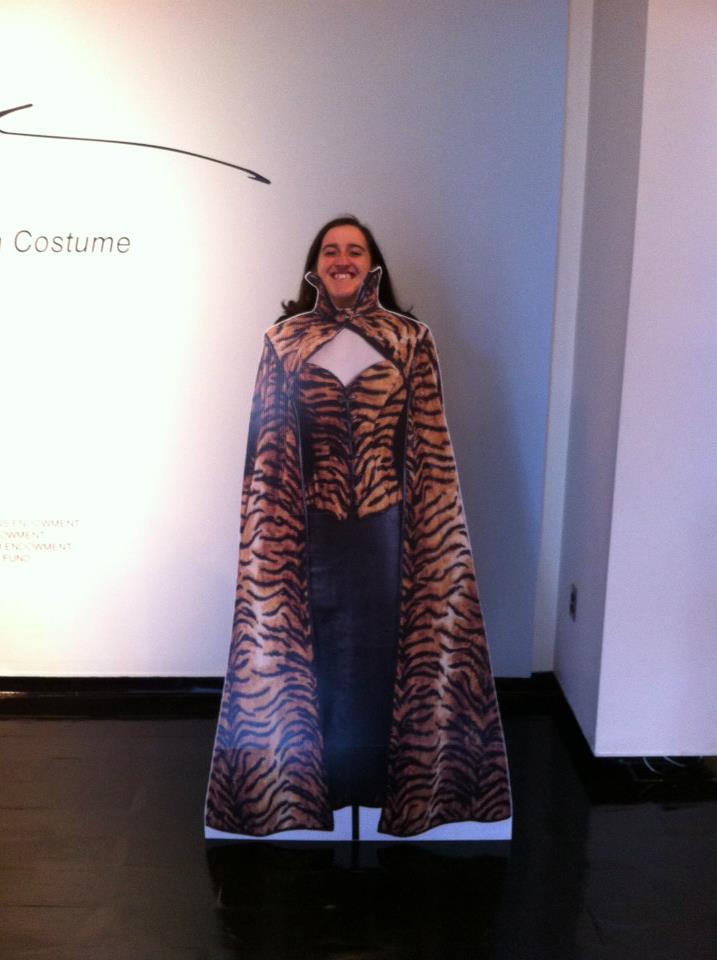Hi All!
For those who don't know, I have a younger sister who is CRAZY about Glenn Close, Maria Friedman, Julie Andrews and Gertrude Lawrence. She runs her own blog dedicated to these ladies and more over on Tumblr under the name LadyLizaElliott. She has some sewing experience, having worked with the University of Rhode Island's costume shop for a number of years, and having me as a sister :) She does not cosplay much, but she has always wanted to make one of the gorgeous costumes Glenn Close wore as Cruella deVil from the live action version of 101 Dalmatians. She decided to finally tackle making one of the costumes this year after my sister in law agreed to dress her two adorable daughters (1.5 and 2.5 years old) as dalmatians for Halloween if my sister dresses as Cruella.
My sister had the chance to visit the Glenn Close costume exhibition on display at the Muscarelle Museum of Art at the William & Mary University earlier this year. She was able to see a number of Cruella costumes up close, and came away with her own costume notes and was generously given one of the full sized cardboard cutouts of the tiger printed corset and cape. It now sits displayed in her closet in her room.
After much debate she decided she'd like to recreate the tiger printed outfit for her Halloween costume. She contacted me asking tips on how to construct the cape of the ensemble. As I began to break it down I decided to document my findings here for others to see!
The original costumes were designed by Anthony Powell and have a number of beautiful design details. There are a number of great promotional shots of Glen in the costume. Here are most of them:
The first thing I'd like to point out is the way the sleeves on the cape are constructed. The first two photos are the best for viewing how they are put together. Take note of the binding surrounding the end of the sleeve. It looks like the back of the cape is tacked to the front of the sleeve at a corner in the front. If you follow the pivot of the binding at the wrist towards the underarm or bottom of the armseye you can see that the binding ends under her armpit. Looking at the picture of the back of the cape there is no indication that the binding is attached to the back anywhere but at the wrist and underarm. To get a better idea of this imagine draping a towel over your arm with one edge hanging longer than the other. Then pinch the shorter corner to the part draped over the back. I think this is how her cape is constructed.
For the yoke portion of the cape it is pretty straightforward. There are some seriously padded shoulders happening, which is easy to recreate by adding shoulder pads between the outer fabric and the lining. The back of the cape has some interesting seaming, which can be seen in this lightened screenshot from the movie:
In this shot it is clear that there is a seam at center back on the collar and the center of the cape. There is likely a side seam at the collar in order to get that exaggerated curved shape. Take note of the binding at the side of the armhole. It does not continue all the way around the armseye, which further points to the idea that the sleeve just wraps around and tacks down under her arm instead of being sewn in as a traditional sleeve.
There's one more picture I'd like to share and that's this one:
This is a shot of the costume from the movie that I lightened so you can see the cape better. Take note of the direction of the tiger stripes here. There is a distinct difference in the direction of the stripes from the sleeve portion and the center back panels. This indicates that there are seams down the back of the cape. It is likely that the cape is constructed in four pieces: two sleeves and two back panels. The seam connecting the back panels to the sleeves likely runs in line with the armseye seam along the back of the yoke.
I did not do any research into the way that the cape closes since my sister got to see the costume up close and has a much better idea of the closure and the brooch that is at the neckline.
To try and illustrate all these details a little easier I did a very rudimentary sketch. This is by no means meant as a definite illustration of what the cape actually looks like, it is just my interpretation in order to hopefully make everything a little easier to visualize.
I also did a very basic sketch of what some of these patterns would look like. Again, this is just for reference and not to scale or the exact shape. These are just for visual reference.
That's all for now. I will keep updating with new information and progress as she works on her costume!



















